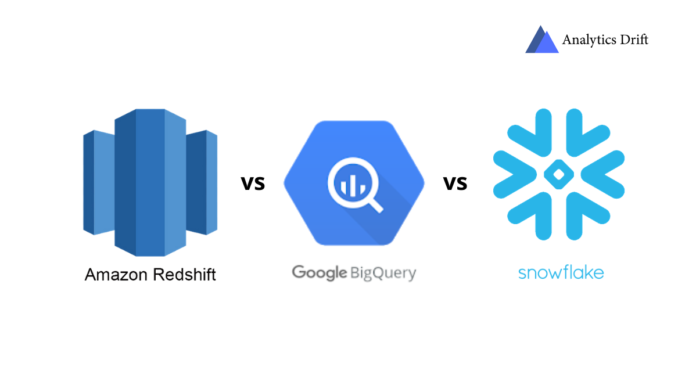As the rate at which data is being collected by organizations is increasing, traditional relational databases have failed to offer the required scale, compute, and flow of data. Consequently, data warehouses became prominent across data-driven organizations for accelerating insights delivery. Today, almost every organization is switching to cloud data warehouses from on-premise infrastructures for streamlining the data workloads across the departments. This is enabling companies to democratize data and boost decision-making for business growth. In the competitive landscape, a proper data warehouse house selection can be the differentiating factor for companies to augment their business processes. However, due to the availability of numerous options for cloud data warehouses, enterprises have struggled to evaluate and find the best fit according to their needs. To simplify the evaluation for companies, this post will focus on comparing famous cloud warehouses — Redshift vs BigQuery vs Snowflake.
While there could be numerous ways in which a data warehouse can be evaluated by organizations, some of the most prominent ways to determine the best data warehouse can be as follows:-
Maintenance In Redshift vs BigQuery vs Snowflake
Organizations embrace managed data warehouses to eliminate maintenance overheads, making it one of the most vital factors while assessing different data warehouse service providers. While Snowflake and BigQuery require little to no maintenance, Redshift requires experts to perform manual maintenance occasionally.
Since storage and compute are not separated in AWS Redshift, you need to set up suitable clusters and optimize the workflow for better performance. But, with BigQuery and Snowflake, initial configuration can be performed without considering different requirements; the flexibility at the later stage by BigQuery and Snowflake removes the necessity of doing due diligence at the very beginning.
AWS also requires you to clear the vacuums — unoccupied spaces — created by the data over a period of time. BigQuery and Snowflake, in contrast, automate the removal of voids to optimize the storage capacity for better performance. Overall, to manage Redshift, an expert familiar with AWS would be vital for you to purge any hindrance during operations. With BigQuery and Snowflake, you do not necessarily need an expert to manage the workflows.
Also Read: Will AWS Lose Its Monopoly To Azure And Google Cloud?
Scalability In Redshift vs BigQuery vs Snowflake
The ability of vertical and horizontal scalability was crucial to the proliferation of cloud data warehouses for organizations. While vertical scaling helps in increasing the load, horizontal scaling enables vast computation. Unlike BigQuery and Snowflake where the storage and compute is different, Redshift has grouped the two called cluster.
Each cluster is a collection of computing resources called nodes, which contains databases. Configuring these clusters is not immediate, disrupting the workflow while amending clusters for vertical or horizontal scaling. But, with Google BigQuery and Snowflake, scaling is performed in a flash to allow users to have continuous access to data warehouses while scaling.
Pricing In Redshift vs BigQuery vs Snowflake
As configurations of clusters are mostly fixed, the pricing with AWS is predictable. You can start with $0.25 per hour and scale according to your needs. However, to optimize costs when you are using it less than usual, you would be required to adjust the clusters on a daily or weekly basis. Therefore, AWS Redshift is popular among companies that have a steady usage of data warehouses. For companies that witness idle time or a surge in usage, it is recommended to fancy Snowflake or BigQuery.
Since Snowflake and BigQuery have different storage and computer pricing, predicting costs is not straightforward. For storage, BigQuery has two pricing models — active storage and long-term storage. While active storage is any table that has been modified in the last 90 days, long-term storage refers to tables that have witnessed an amendment for 90 days.
The active storage plan costs $0.020 per GB, and the long-term storage plan costs $0.010 per GB. Google also offers two pricing models for computing — on-demand pricing and flat-rate pricing. With on-demand, you are charged for each query, which is $5 per TB (the first 1TB per month is free). However, you are not charged for queries that return an error or provide results from cache. And for flat-rate pricing, you will shell out $2,000 for 100 slots — a dedicated query processing capacity.
Snowflake has set the storage pricing of $23 per TB, which is almost similar to BigQuery’s storage cost. However, you will be charged $40 per TB if you opt for on-demand usage. And for computing resources, Snowflake charges $0.00056 per second per credit for Standard Edition.
The pricing of Snowflake is more complicated, but it makes up with its cluster management, which stops clusters when not in use. As a result, you save significantly on processing costs. As per a benchmark, Snowflake is slightly cheaper than BigQuery on regular usage.
Performance In Redshift vs BigQuery vs Snowflake
Evaluating a data warehouse’s performance can be subjective and can differ based on the metric you want to consider. According to a benchmark, separating compute with storage has a unique advantage in processing speed. For instance, Snowflake processes 6 to 60 million rows between 2 to 10 seconds.
But, as per another benchmark that assessed Redshift vs BigQuery vs Snowflake on 24 tables, with the largest one containing 4 million rows of data, the average runtime of 99 TPC-DS queries for BigQuery was 11.18 seconds, Redshift was 8.24, and Snowflake was 8.21 seconds. If your usage is intensive, leverage Redshift or Snowflake is an ideal choice.
Conclusion
Accessing Redshift vs BigQuery vs Snowflake can be a lot easier when your requirements are well-defined. If you are looking for heavy and steady usage without maintenance overhead, Snowflake would be the best choice. On the other hand, if you want flexibility with performance, Redshift should be the go-to service for data warehousing. And in case of varied workloads, BigQuery shall cater to your needs with minimal cost since it charges you for the queries you request.


